Zimmer089 – Someonelikeme – Selected (Germany)
mp3, 320kbps, stereo, elektro, breaks
089.01 – Someonelikeme – Lucapons
089.02 – Someonelikeme – DMCA
089.03 – Someonelikeme – Disher
stream & download -> archive.org
stream & download -> sonicsquirrel.net
stream & download -> last.fm
download ZIP (MP3 | 36MB)
Artwork (667px)
[by nikola janeski]
Whether or not selection takes place depends on the conditions in which the individuals of a species find themselves. Adults, juveniles, embryos, and even eggs and sperm may undergo selection. Factors fostering selection include limits on resources (nourishment, habitat space, mates) and the existence of threats (predators, disease, adverse weather). Biologists often refer to such factors as selective pressures.
Natural selection is the most familiar type of selection by name. The breeding of dogs, cows and horses, however, represents “artificial selection”. Subcategories of natural selection are also sometimes distinguished. These include sexual selection, ecological selection, stabilizing selection, disruptive selection and directional selection (more on these below).
Selection occurs only when the individuals of a population are diverse in their characteristics—or more specifically when the traits of individuals differ with respect to how well they equip them to survive or exploit a particular pressure. In the absence of individual variation, or when variations are selectively neutral, selection does not occur.
Meanwhile, selection does not guarantee that advantageous traits or alleles will become prevalent within a population. Another process of gene frequency alteration in a population is called genetic drift, which acts over genes that aren’t under selection. But, this drift can’t overcome natural selection itself, as it is a ‘random sampling’ process and Natural Selection is actually an evolutive force. In the face of selection even a so-called deleterious allele may become universal to the members of a species. This is a risk primarily in the case of “weak” selection (e.g. an infectious disease with only a low mortality rate) or small populations. //wikipedia
